Changing Land Use and Urban Dynamics around an Industrial Zone in Bangladesh: A Remote Sensing Analysis
Abstract
1. Introduction
2. Materials and Methods
2.1. Study Area
2.2. Satellite Image Dataset and Processing Steps
2.3. Image Classification, Analysis and Visualization Process
2.4. Field Observations and Literature Review
3. Results
4. Discussion
5. Conclusions
Supplementary Materials
Author Contributions
Funding
Data Availability Statement
Acknowledgments
Conflicts of Interest
References
- Islam, A.; Sobhani, F.A. Determinants of outsourcing decision in the manufacturing industry in Bangladesh. Bus. Rev. 2010, 5, 127–148. [Google Scholar] [CrossRef]
- Adhikary, B.K. FDI, Trade Openness, Capital Formation, and Economic Growth in Bangladesh: A Linkage Analysis. Int. J. Bus. Manag. 2010, 6, 16. [Google Scholar] [CrossRef]
- Lucas, R.E.B.; Wheeler, D.; Hettige, H. Economic Development, Environmental Regulation, and the International Migration of Toxic Industrial Pollution, 1960–1988; World Bank Publications: Herndon, VA, USA, 1992; Volume 1062. [Google Scholar]
- Harrison, A. The role of multinationals in economic development: The benefits of FDI. Columbia J. World Bus. 1994, 29, 6–11. [Google Scholar] [CrossRef]
- Millimet, D.L.; Roy, J. Empirical Tests of the Pollution Haven Hypothesis When Environmental Regulation is Endogenous: Empirical Tests of the Pollution Haven Hypothesis. J. Appl. Econom. 2016, 31, 652–677. [Google Scholar] [CrossRef]
- Eskeland, G.S.; Harrison, A.E. Moving to greener pastures? Multinationals and the pollution haven hypothesis. J. Dev. Econ. 2003, 70, 1–23. [Google Scholar] [CrossRef]
- Aliyu, M.A. Foreign Direct Investment and the Environment: Pollution Haven Hypothesis Revisited; Citeseer: Lübeck, Germany, 2005. [Google Scholar]
- Brown, R.E. Environmental Regulation as a Determinant of Trade: An Empirical Investigation of the “Pollution Haven Hypothesis” in the Context of International Trade. Master’s Thesis, University of Cape Town, Cape Town, South Africa, 2016. [Google Scholar]
- Winkler, K.; Fuchs, R.; Rounsevell, M.; Herold, M. Global land use changes are four times greater than previously estimated. Nat. Commun. 2021, 12, 2501. [Google Scholar] [CrossRef] [PubMed]
- Ahmed, K.; Shahbaz, M.; Kyophilavong, P. Revisiting the emissions-energy-trade nexus: Evidence from the newly industrializing countries. Environ. Sci. Pollut. Res. 2016, 23, 7676–7691. [Google Scholar] [CrossRef]
- Alvarado, R.; Toledo, E. Environmental degradation and economic growth: Evidence for a developing country. Environ. Dev. Sustain. 2017, 19, 1205–1218. [Google Scholar] [CrossRef]
- Christie, M.; Carley, I. Managing Sustainable Development, 2nd ed.; Routledge: London, UK, 2017; ISBN 978-1-315-09152-5. [Google Scholar]
- Gorelick, N.; Hancher, M.; Dixon, M.; Ilyushchenko, S.; Thau, D.; Moore, R. Google Earth Engine: Planetary-scale geospatial analysis for everyone. Remote Sens. Environ. 2017, 202, 18–27. [Google Scholar] [CrossRef]
- Johansen, K.; Phinn, S.; Taylor, M. Mapping woody vegetation clearing in Queensland, Australia from Landsat imagery using the Google Earth Engine. Remote Sens. Appl. Soc. Environ. 2015, 1, 36–49. [Google Scholar] [CrossRef]
- Dong, J.; Xiao, X.; Menarguez, M.A.; Zhang, G.; Qin, Y.; Thau, D.; Biradar, C.; Moore, B. Mapping paddy rice planting area in northeastern Asia with Landsat 8 images, phenology-based algorithm and Google Earth Engine. Remote Sens. Environ. 2016, 185, 142–154. [Google Scholar] [CrossRef]
- Xiong, J.; Thenkabail, P.S.; Gumma, M.K.; Teluguntla, P.; Poehnelt, J.; Congalton, R.G.; Yadav, K.; Thau, D. Automated cropland mapping of continental Africa using Google Earth Engine cloud computing. ISPRS J. Photogramm. Remote Sens. 2017, 126, 225–244. [Google Scholar] [CrossRef]
- Goldblatt, R.; You, W.; Hanson, G.; Khandelwal, A.K. Detecting the Boundaries of Urban Areas in India: A Dataset for Pixel-Based Image Classification in Google Earth Engine. Remote Sens. 2016, 8, 634. [Google Scholar] [CrossRef]
- Kennedy, R.E.; Yang, Z.; Gorelick, N.; Braaten, J.; Cavalcante, L.; Cohen, W.B.; Healey, S. Implementation of the LandTrendr Algorithm on Google Earth Engine. Remote Sens. 2018, 10, 691. [Google Scholar] [CrossRef]
- Maxwell, A.E.; Warner, T.A.; Fang, F. Implementation of machine-learning classification in remote sensing: An applied review. Int. J. Remote Sens. 2018, 39, 2784–2817. [Google Scholar] [CrossRef]
- Sidhu, N.; Pebesma, E.; Câmara, G. Using Google Earth Engine to detect land cover change: Singapore as a use case. Eur. J. Remote Sens. 2018, 51, 486–500. [Google Scholar] [CrossRef]
- Xu, H. Extraction of Urban Built-up Land Features from Landsat Imagery Using a Thematicoriented Index Combination Technique. Photogramm. Eng. Remote Sens. 2007, 73, 1381–1391. [Google Scholar] [CrossRef]
- Kshetri, T. NDVI, NDBI & NDWI Calculation Using Landsat 7, 8. Available online: https://www.linkedin.com/pulse/ndvi-ndbi-ndwi-calculation-using-landsat-7-8-tek-bahadur-kshetri/ (accessed on 3 June 2023).
- USGS What Are the Best Landsat Spectral Bands for Use in My Research?|U.S. Geological Survey. Available online: https://www.usgs.gov/faqs/what-are-best-landsat-spectral-bands-use-my-research (accessed on 3 June 2023).
- Huang, C.; Davis, L.S.; Townshend, J.R.G. An assessment of support vector machines for land cover classification. Int. J. Remote Sens. 2002, 23, 725–749. [Google Scholar] [CrossRef]
- BBS. Population and Housing Census—2011: National Report—Vol. 2: Union Statistics; Bangladesh Bureau of Statistics (BBS): Dhaka, Bangladesh, 2014.
- Ahmed, G.; Anwar, H.M.; Chowdhury, D.A.; Ahmed, J.U.; Khan, M.A.; Hoque, S. Pollution status of trace metals in groundwater due to industrial activities in and around Dhaka export processing zone, Bangladesh. Int. J. Econ. Environ. Geol. 2012, 3, 43–52. [Google Scholar]
- Akter, M.; Sikder, T.; Ullah, A.K.M.A. Water Quality Assessment of an Industrial Zone Polluted Aquatic Body in Dhaka, Bangladesh. Am. J. Environ. Prot. 2014, 3, 232. [Google Scholar] [CrossRef][Green Version]
- Muzzini, E.; Aparicio, G. Bangladesh: The Path to Middle-Income Status from an Urban Perspective; World Bank: Washington, DC, USA, 2013; ISBN 978-0-8213-9859-3. [Google Scholar]
- World Bank Urban Population (% of Total Population)—Bangladesh. Available online: https://data.worldbank.org/indicator/SP.URB.TOTL.IN.ZS?locations=BD (accessed on 3 June 2023).
- BBS. Statistical Yearbook of Bangladesh 2018; Bangladesh Bureau of Statistics (BBS): Dhaka, Bangladesh, 2019.
- Bahauddin, K.M.; Rahman, M.M.; Ahmed, F. Towards Urban City with Sustainable Buildings: A Model for Dhaka City, Bangladesh. Environ. Urban. ASIA 2014, 5, 119–130. [Google Scholar] [CrossRef]
- Khondker, H.W.; Mohith, M.A.; Mannan, A.V.; Mannan, A.V. Unsuccessful city governance ensuing unplanned urban growth and disorder between city authorities: A review of Dhaka city. Bangladesh Res. Publ. J. 2015, 11, 159–168. [Google Scholar]
- Zohir, S.C. Household response to gender issues: A survey on households of female EPZ workers in Bangladesh. In Tracking Gender Equity under Economic Reforms: Continuity and Change in South Asia; Idrc: Ottawa, ON, Canada, 2003; p. 64. [Google Scholar]
- Kabeer, N.; Mahmud, S. Globalization, gender and poverty: Bangladeshi women workers in export and local markets. J. Int. Dev. 2004, 16, 93–109. [Google Scholar] [CrossRef]
- Labowitz, S.; Baumann-Pauly, D. Beyond the Tip of the Iceberg: Bangladesh’s Forgotten Apparel Workers. Available online: https://www.academia.edu/download/50887296/Bangladeshs-Forgotten-Apparel-Workers.pdf (accessed on 3 June 2023).
- RAJUK. Preparation of Detailed Area Plan (DAP) for Dhaka Metropolitan Development Plan (DMDP) of Location-15: Report—V.; Rajdhani Unnayan Kartripakkha (RAJUK): Dhaka, Bangladesh, 2010.
- Fakir, A.; Miah, M.; Hossain, S. Export Diversification and Role of Export Processing Zones (EPZ) in Bangladesh. ASA Univ. Rev. 2013, 7. [Google Scholar]
- RAJUK. Draft Dhaka Structure Plan Report 2016–2035; Rajdhani Unnayan Kartripakkha (RAJUK): Dhaka, Bangladesh, 2016.
- Basak, P. Spatio-Temporal Trends and Dimensions of Urban Growth in Dhaka Metropolitan Region: A GIS and Remote Sensing Analysis. Master’s Thesis, Bangladesh University of Engineering and Technology (BUET), Dhaka, Bangladesh, 2006. [Google Scholar]
- Sarkar, D.P.; Elahi, M.; Rashid, P.D.S. Land Use and Land Cover Change Detection of Ganakbari Mauja in Savar Upozila. Glob. J. Hum.-Soc. Sci. 2016, 16, 53–63. [Google Scholar]
- Mahbub, A.; Tanvir, H.M.; Afrin, L.T. An evaluation of environmental and social impact due to industrial activities-A case study of Bangshi river around Dhaka Export Processing Zone (DEPZ), Bangladesh. Int. Res. J. Environ. Sci. 2014, 3, 103–111. [Google Scholar]
- Mallick, S. Industrialization water pollution and social change: A case of basin based village in Bangladesh. Int. J. Sci. Eng. Res. 2013, 4, 759–774. [Google Scholar]
- Khan, M.; Alam, M.; Islam, M.; Hassan, M.; Al-Mansur, M. Environmental Pollution Around Dhaka EPZ and its Impact on Surface and Groundwater. Bangladesh J. Sci. Ind. Res. 2011, 46, 153–162. [Google Scholar] [CrossRef]
- Islam, M.S.; Sultana, A.; Sultana, M.S.; Shammi, M.; Uddin, M.K. Surface Water Pollution around Dhaka Export Processing Zone and Its Impacts on Surrounding Aquatic Environment. J. Sci. Res. 2016, 8, 413–425. [Google Scholar] [CrossRef][Green Version]
- Rahman, S.H.; Khanam, D.; Adyel, T.M.; Islam, M.S.; Ahsan, M.A.; Akbor, M.A. Assessment of Heavy Metal Contamination of Agricultural Soil around Dhaka Export Processing Zone (DEPZ), Bangladesh: Implication of Seasonal Variation and Indices. Appl. Sci. 2012, 2, 584–601. [Google Scholar] [CrossRef]
- Goni, M.A.; Ahmad, J.U.; Halim, M.A.; Mottalib, M.A.; Chowdhury, D.A. Uptake and Translocation of Metals in Different Parts of Crop Plants Irrigated with Contaminated Water from DEPZ Area of Bangladesh. Bull. Environ. Contam. Toxicol. 2014, 92, 726–732. [Google Scholar] [CrossRef]
- Roy, P. Savar in grave peril. Dly. Star 2009. [Google Scholar]
- Sarker, P.K. Water pollution still rampant. Dly. Star 2012. [Google Scholar]
- Faridatul, M.I. A Comparative Study on Precipitation and Groundwater Level Interaction in the Highly Urbanized Area and Its Periphery. Curr. Urban Stud. 2018, 6, 209–222. [Google Scholar] [CrossRef]
- Hasan, M.; Islam, M.A.; Aziz Hasan, M.; Alam, M.J.; Peas, M.H. Groundwater vulnerability assessment in Savar upazila of Dhaka district, Bangladesh—A GIS-based DRASTIC modeling. Groundw. Sustain. Dev. 2019, 9, 100220. [Google Scholar] [CrossRef]
- Abdelsalam, S.M.M. Water Management of Textile Sector in Bangladesh: Analysis of Partnership for Cleaner Textile Project in Bangladesh. Master’s Thesis, University of Twente, Enschede, The Netherlands, 2019. [Google Scholar]
- Hossain, L. Water Footprint Assessment of RMG Sector of Bangladesh; Bangladesh University of Engineering & Technology (BUET): Dhaka, Bangladesh, 2017. [Google Scholar]
- Restiani, P. Water Governance Mapping Report: Textile Industry Water Use in Bangladesh; Sweden Textile Water Initiative (SIWI): Stockholm, Sweden, 2016. [Google Scholar]
- Byron, R.K. 24 new economic zones get nod. Dly. Star 2015. [Google Scholar]
- Ahmed, R. Investment is increasing in Economic Zones, Exports also started. Dly. Prothom Alo 2019, 1. [Google Scholar]
- Rehman, A.; Song, J.; Haq, F.; Ahamad, M.I.; Sajid, M.; Zahid, Z. Geo-physical hazards microzonation and suitable site selection through multicriteria analysis using geographical information system. Appl. Geogr. 2021, 135, 102550. [Google Scholar] [CrossRef]
- GED. Sustainable Development Goals: Bangladesh Progress Report 2018|United Nations Development Programme; General Economic Division (GED), Bangladesh Planning Commission: Dhaka, Bangladesh, 2018.
- Morgan, R.K. Environmental impact assessment: The state of the art. Impact Assess. Proj. Apprais. 2012, 30, 5–14. [Google Scholar] [CrossRef]
- Moore, R.T.; Hansen, M.C. Google Earth Engine: A new cloud-computing platform for global-scale earth observation data and analysis. AGU Fall Meet. Abstr. 2011, 2011, IN43C-02. [Google Scholar]
- Hird, J.N.; DeLancey, E.R.; McDermid, G.J.; Kariyeva, J. Google Earth Engine, Open-Access Satellite Data, and Machine Learning in Support of Large-Area Probabilistic Wetland Mapping. Remote Sens. 2017, 9, 1315. [Google Scholar] [CrossRef]

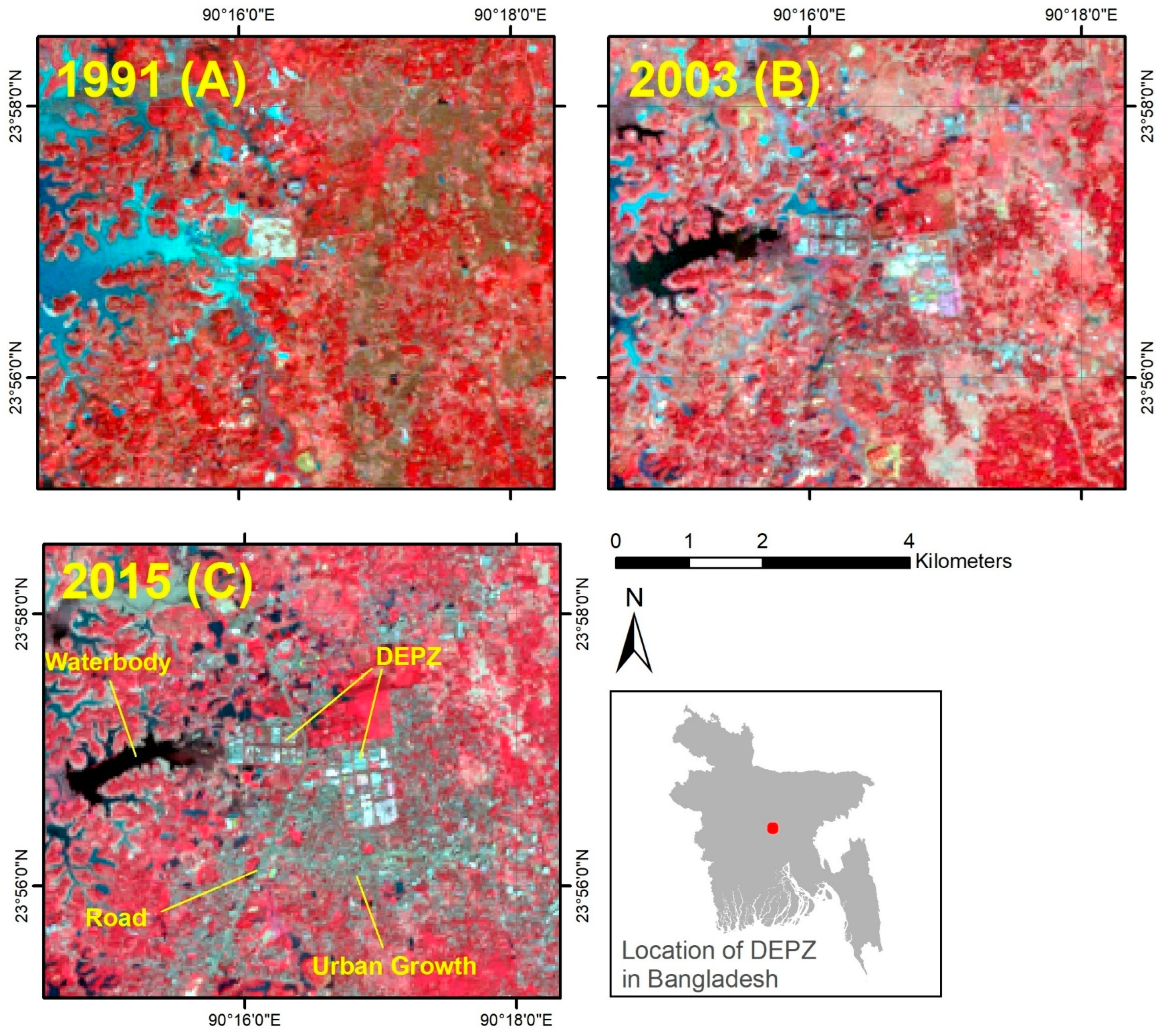

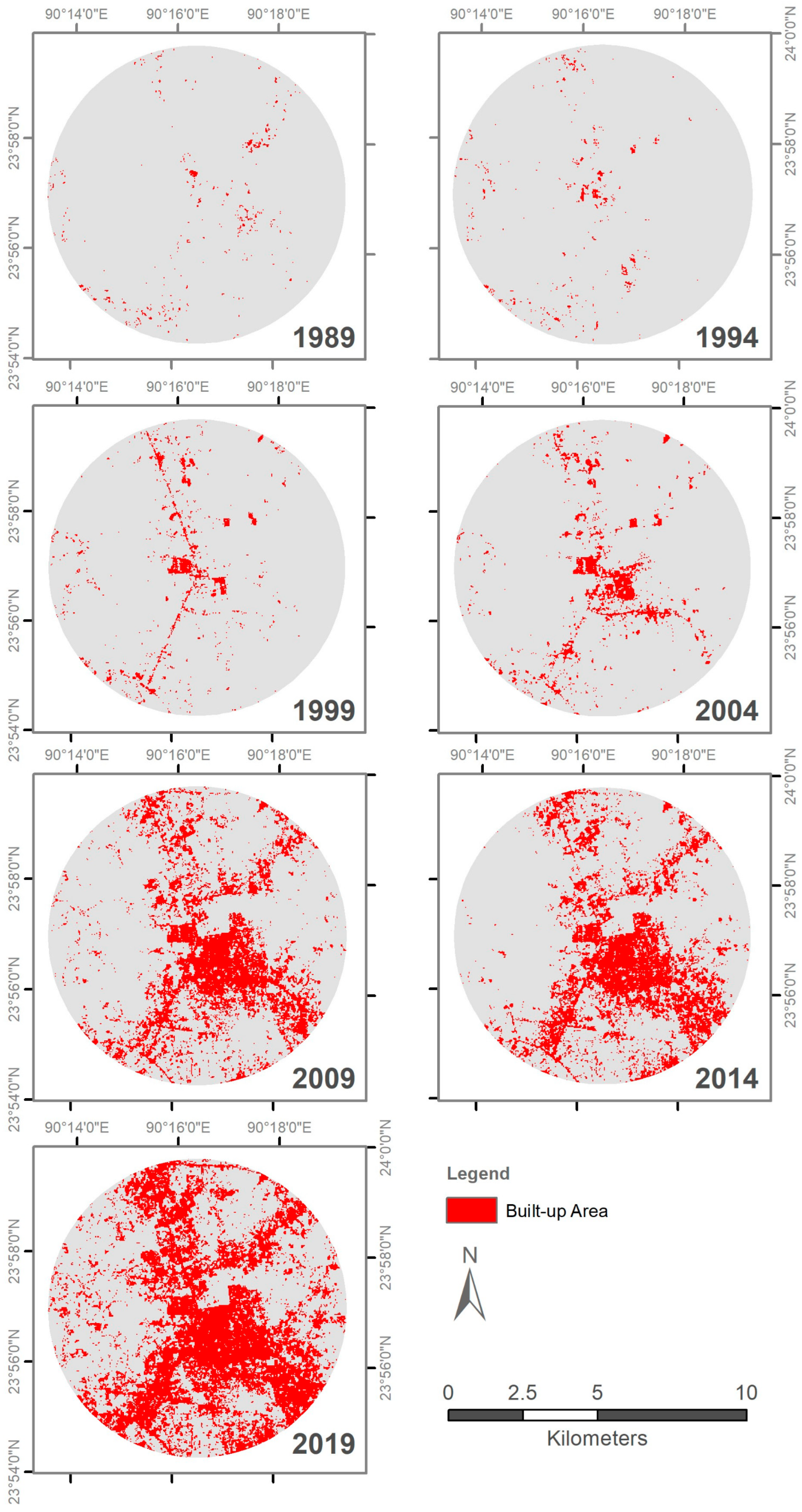
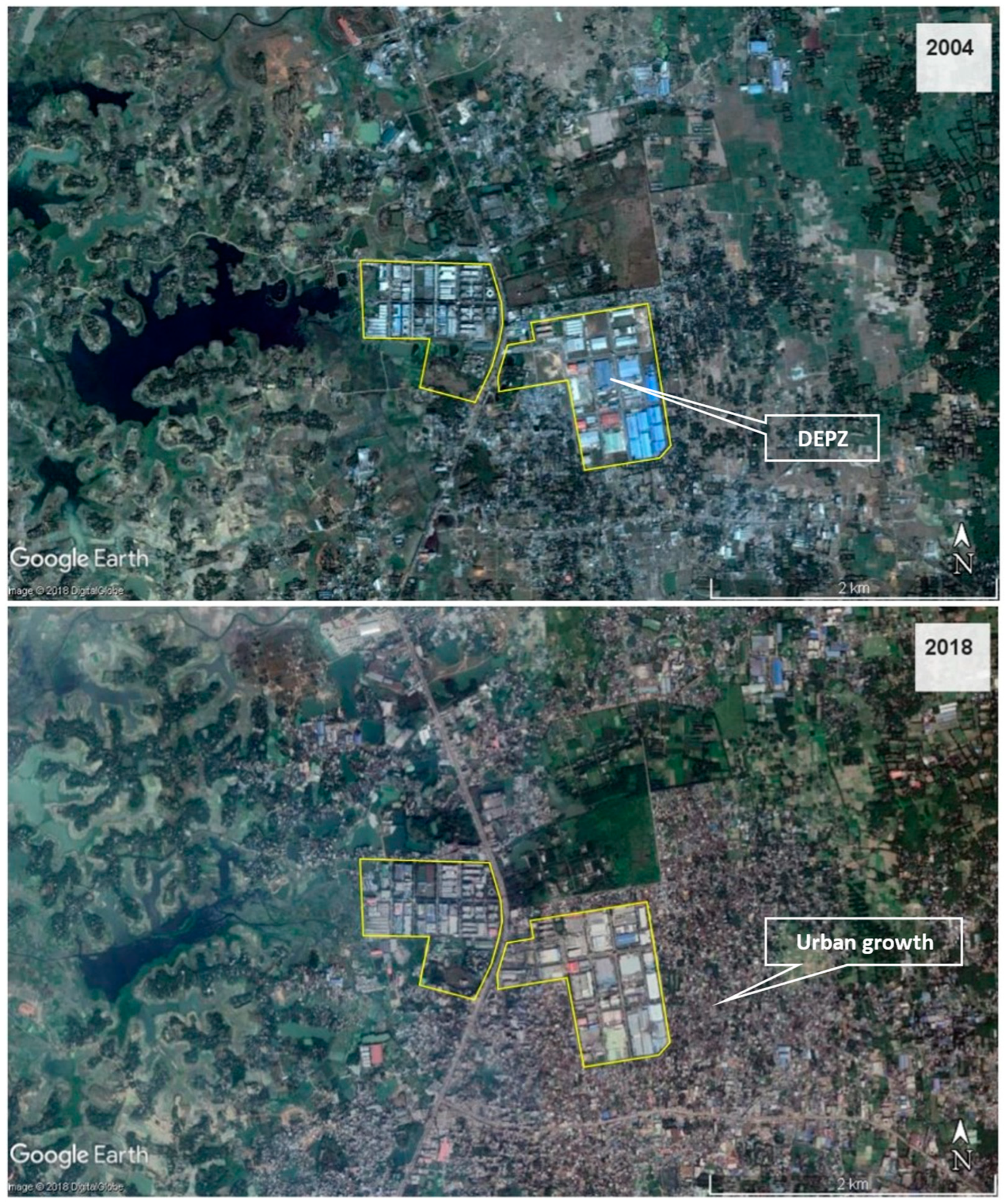

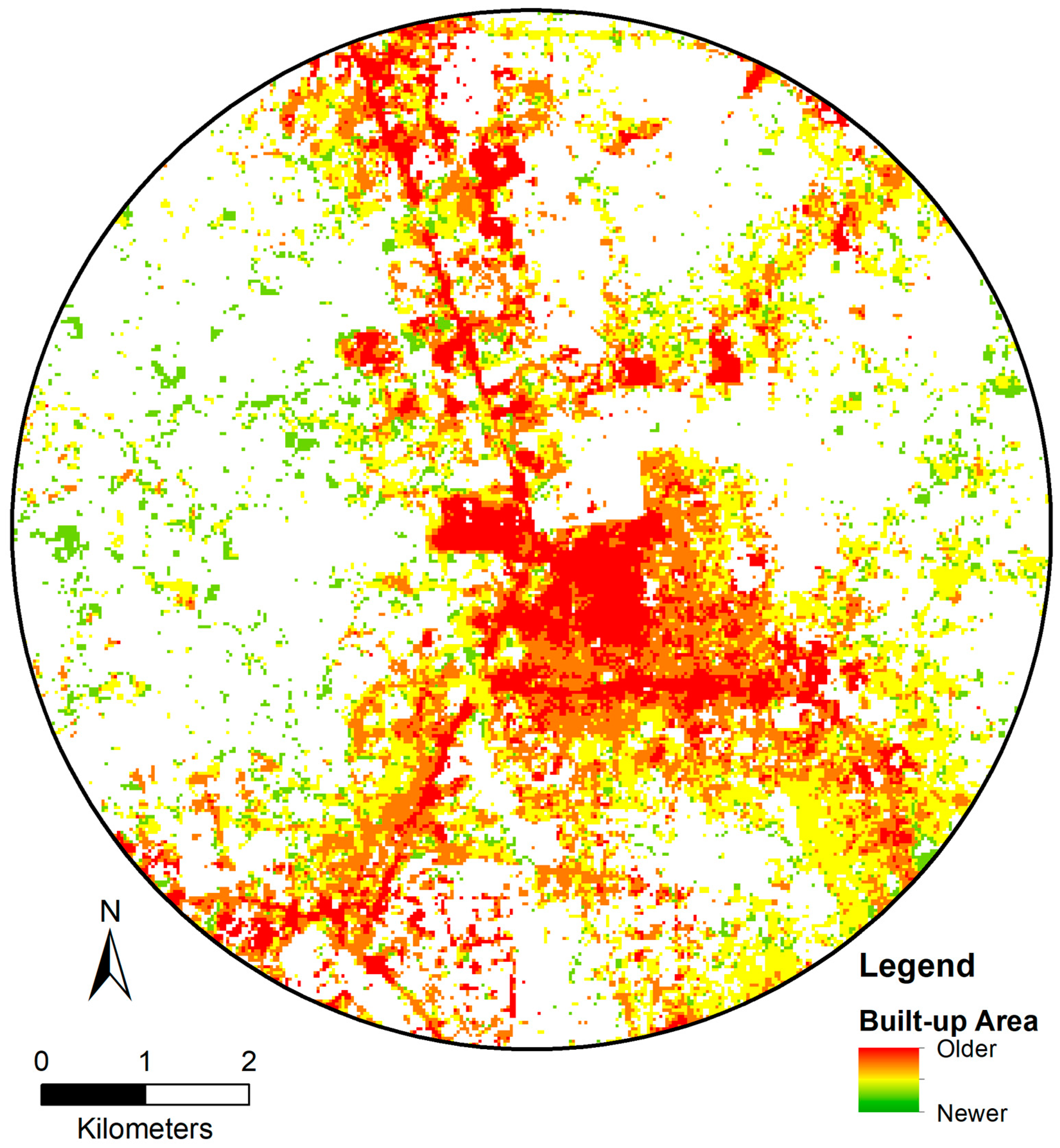
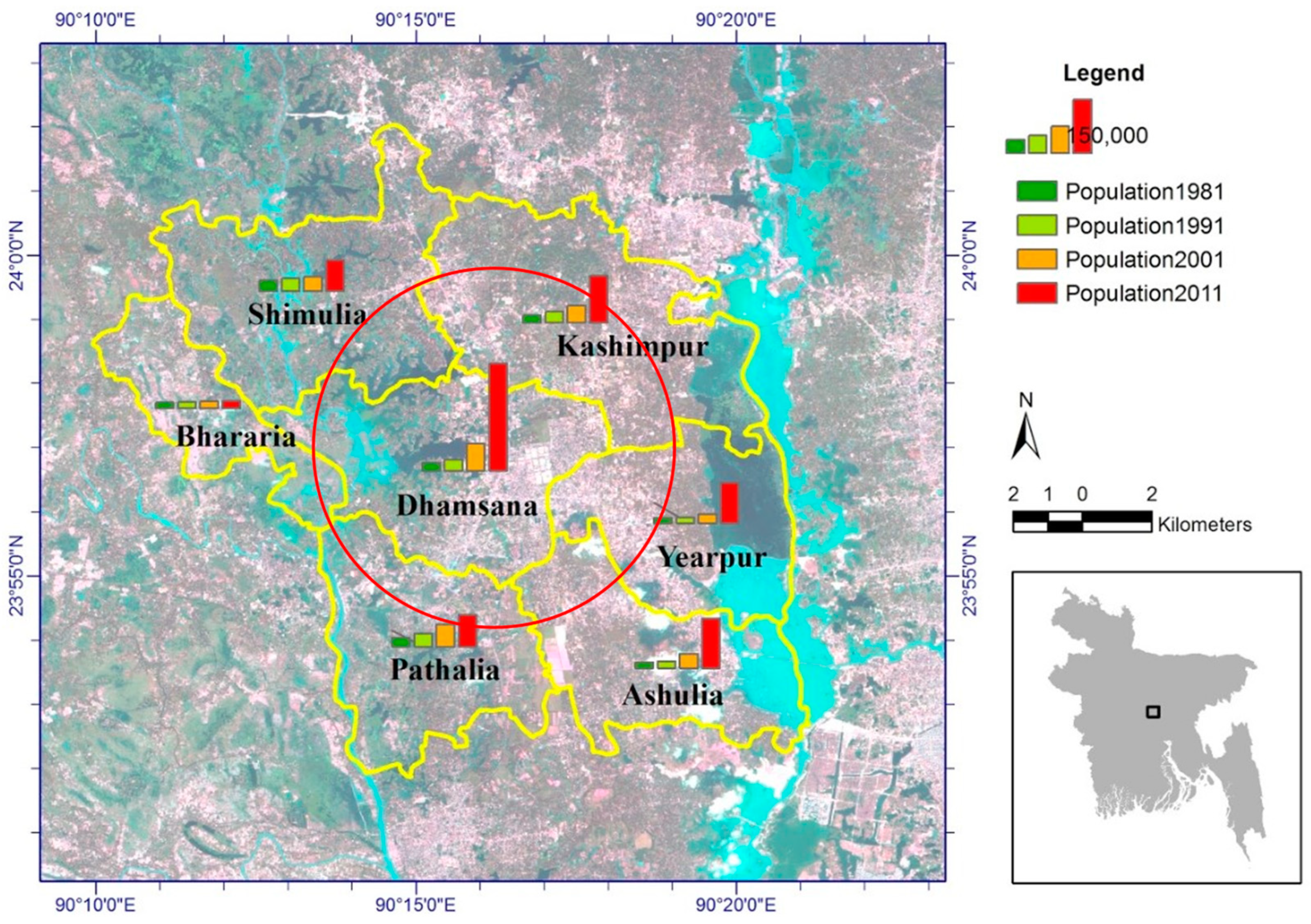

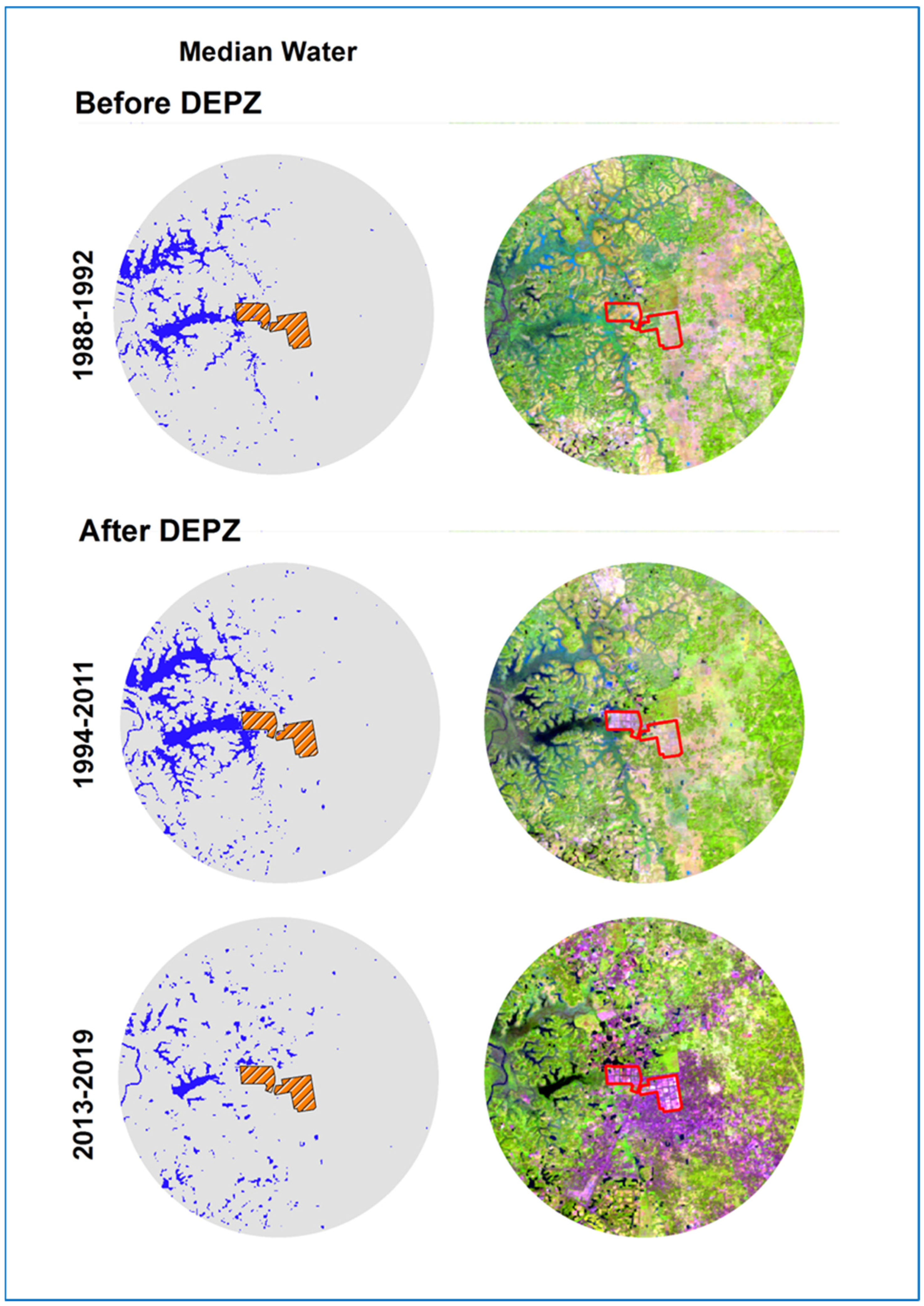
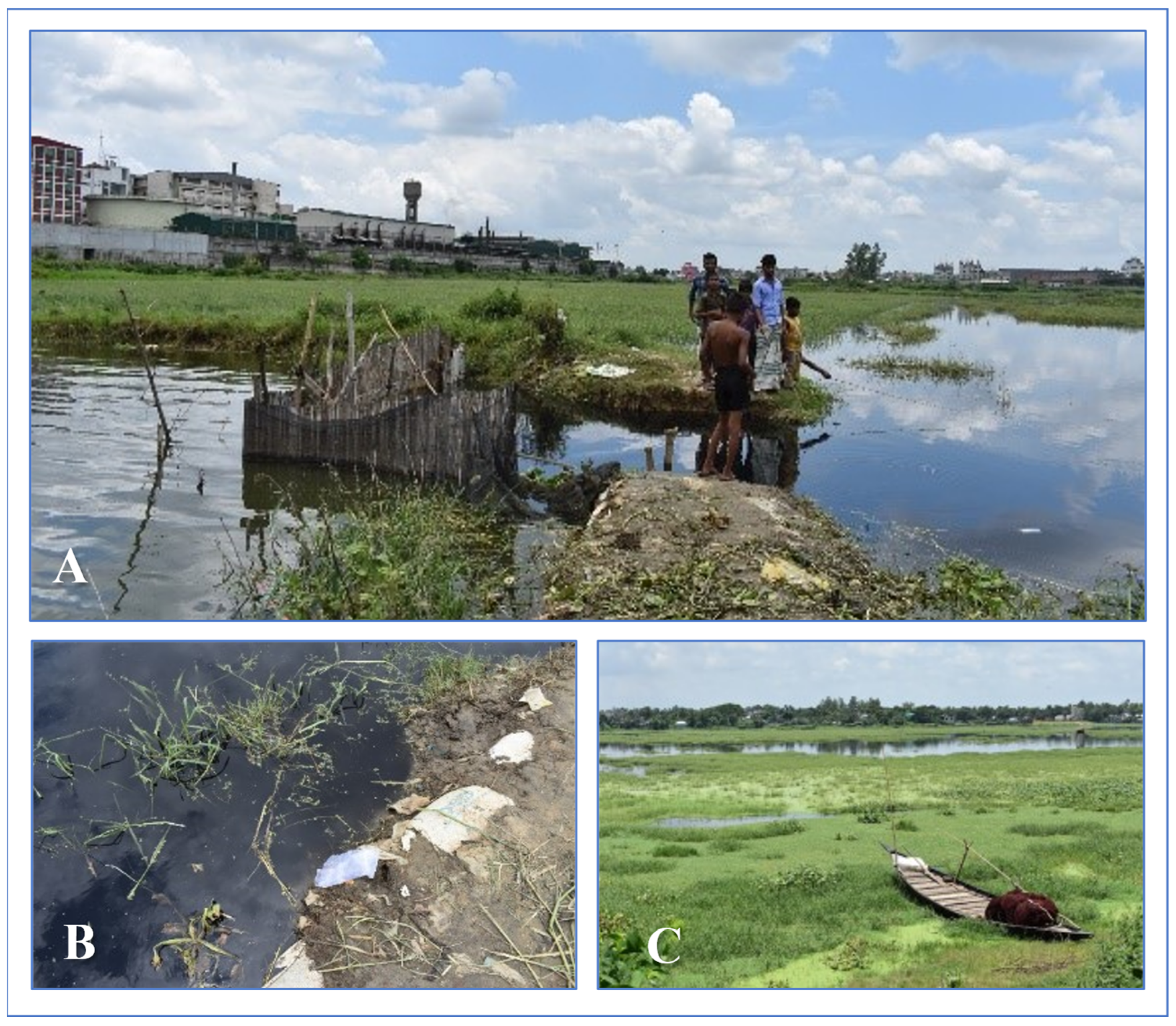
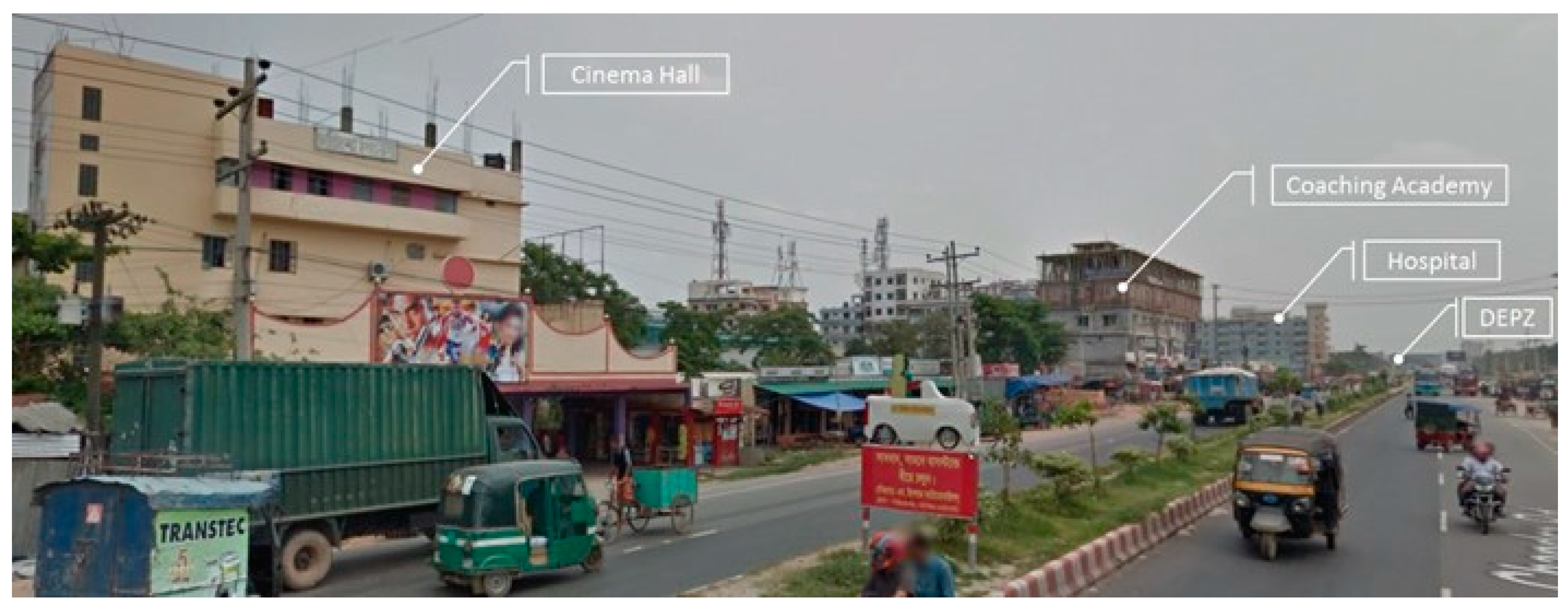

| Sensor/Representative Year | Image Acquisition Date | Cloud Coverage (%) | Used for Training | Overall Accuracy of Trained Classification Model (%) | Validated Classified Image | Validated Accuracy of the Classified Image (Kappa Statistics) |
|---|---|---|---|---|---|---|
| Landsat 8 | ||||||
| 2019 | 23 January 2019 | 0 | Yes | 95.6 | Yes | 0.92 |
| 2014 | 26 February 2014 | 2 | Yes | 0.88 | ||
| Landsat 5 | ||||||
| 2009 | 11 January 2009 | 1 | Yes | 98.9 | Yes | 0.94 |
| 2004 | 15 February 2004 | 6 | Yes | 0.90 | ||
| 1999 | 1 February 1999 | 0 | ||||
| 1994 | 2 January 1994 | 0 | ||||
| 1989 | 4 January 1989 | 3 |
| Year | Built-Up Area (Sq. km) | Built-Up Area (%) | Growth of Built-Up Area in Previous Five Years (%) |
|---|---|---|---|
| 1989 | 0.85 | 1.1 | - |
| 1994 | 0.90 | 1.1 | 0.1 |
| 1999 | 2.50 | 3.2 | 2.0 |
| 2004 | 5.31 | 6.8 | 3.6 |
| 2009 | 10.67 | 13.6 | 6.8 |
| 2014 | 15.98 | 20.3 | 6.8 |
| 2019 | 22.24 | 28.3 | 8.0 |
| Year | Built-Up Area (Sq. km) | Total Population in 7 Unions * around DEPZ (with a Two-Year Lag) |
|---|---|---|
| 1989 | 0.85 | 197,000 |
| 1994 | 0.90 | 270,000 ** |
| 1999 | 2.50 | 319,000 |
| 2004 | 5.31 | 673,000 ** |
| 2009 | 10.67 | 909,000 |
| 2014 | 15.98 | 1,371,000 ** |
| 2019 | 22.24 | 1,679,000 ** |
Disclaimer/Publisher’s Note: The statements, opinions and data contained in all publications are solely those of the individual author(s) and contributor(s) and not of MDPI and/or the editor(s). MDPI and/or the editor(s) disclaim responsibility for any injury to people or property resulting from any ideas, methods, instructions or products referred to in the content. |
© 2023 by the authors. Licensee MDPI, Basel, Switzerland. This article is an open access article distributed under the terms and conditions of the Creative Commons Attribution (CC BY) license (https://creativecommons.org/licenses/by/4.0/).
Share and Cite
Basak, P.; Momtaz, S.; Gaston, T.F.; Dey, S. Changing Land Use and Urban Dynamics around an Industrial Zone in Bangladesh: A Remote Sensing Analysis. Land 2023, 12, 1753. https://doi.org/10.3390/land12091753
Basak P, Momtaz S, Gaston TF, Dey S. Changing Land Use and Urban Dynamics around an Industrial Zone in Bangladesh: A Remote Sensing Analysis. Land. 2023; 12(9):1753. https://doi.org/10.3390/land12091753
Chicago/Turabian StyleBasak, Palash, Salim Momtaz, Troy F. Gaston, and Soma Dey. 2023. "Changing Land Use and Urban Dynamics around an Industrial Zone in Bangladesh: A Remote Sensing Analysis" Land 12, no. 9: 1753. https://doi.org/10.3390/land12091753
APA StyleBasak, P., Momtaz, S., Gaston, T. F., & Dey, S. (2023). Changing Land Use and Urban Dynamics around an Industrial Zone in Bangladesh: A Remote Sensing Analysis. Land, 12(9), 1753. https://doi.org/10.3390/land12091753








